by Cassie, September 21st, 2009 | 2 Comments
We successfully completed our bike tour of the Netherlands and Belgium! We took the train from Mechelen, Belgium (just north of Brussels) to Freiburg, Germany. We will spend a day or two biking through the Black Forest, and then, we will start our bike tour along the Danube River.
We will try to update the blog soon with details of our adventures with biking through Europe. For now, I have uploaded a bunch of our photos.
Netherlands: http://www.grinnellgallery.com/photos/schmitzc/bike_tour_netherlands/
Belgium: http://www.grinnellgallery.com/photos/schmitzc/bike_tour_belgium/
by Cassie, September 7th, 2009 | 3 Comments
We were planning to head out on our bike tour on Sunday, but we had some bad luck when putting our bikes back together on Saturday night. I have a bolt that is holding the seat on and the bike rack. Unfortunately, the bolt got completely stripped when I was trying to tighten it after putting my seat back up. Since everything is closed on Sunday, we were not able to get a replacement bolt until Monday. Plus, we don’t even have the tools to get the stripped bolt off my bike to replace it. Fortunately, we were able to stay at the Bicycle Hotel one more night, and we just had to move to another room. With another stroke of good luck, our savior, Clemens, was working at the bike garage for the Bicycle Hotel on Sunday morning when we went to drop off some of our bike stuff. Clemens let us use his tools to get off the stripped bolt. We couldn’t get it off with pliers, so we ended up sawing it off with a small file saw. Then, Clemens also had a replacement bolt that worked perfectly on my bike. We were so relieved to have our bikes ready for our bike tour!
Since we had an extra day, we decided to go to the Rijksmuseum. It was really neat to see the amazing paintings done by the Dutch masters, and the painstaking detail in their paintings. The paintings were so realistic that they looked like photographs. However, after three hours of looking at paintings, we couldn’t stand seeing another painting of a vase of flowers or a portrait of a formally posed person dressed in black. 🙂
Also, since our bikes were finally in working order, we went for our first bike ride around Amsterdam. It is awesome to ride around Amsterdam with the dedicated bike lanes and stop lights just for bikes. It can also be a little terrifying because the cars drive so fast and so close to you when you are riding in the bike lane. The trams also go right next to the bike lanes. It is a great city for biking, but it is also very fast-paced and chaotic. Monday, we head out of Amsterdam into the countryside, and we’re ready to the leave hustle and bustle of Amsterdam.
by Cassie, September 7th, 2009 | 1 Comment
Today, we wandered all over Amsterdam, and here are a series of photos from our walking tour.

This is sign at the pedestrian crosswalk showing you how to push the button for the walk sign. I’m not sure if I could have figured out how to push the button without it. 🙂

In the US, we have no parking signs for cars. Since there are bikes parked all over the city, they have to put up no bike parking signs.

They also have special stop lights for the bikes.

I saw this three wheeled miniature truck parked on the street and had to take a picture. 🙂

Koninklijk Paleis on Dam Square

Noorderkerk (North Church)

Oude Kerk (Old Church)

Canal by Oude Kerk

Canal by Oude Kerk

Stairstep gable and bell gable

Houseboat with floating garden in front

Free bike ferry across harbor
by Cassie, September 6th, 2009 | No Comments
Westerkerk (West Church)
Westerkerk is in the Jordaan neighborhood. It has the highest church tower in Amsterdam of 85 meters, and you can climb the tower. You can only go about halfway up the tower, at 42 meters, where you can walk outside around the tower and get an amazing view of the city. The climb up the tower is very steep and treacherous, and you could definitely not do this in the US. The first person that tripped and fell would sue the church and that would be the end of the tower tour. As you climb the tower, you can also see the bells in the tower that are pulled by ropes below. They also have 50 bells for carillon concerts every Tuesday.

Bell inside tower

View from tower

View from church

View from tower

We also went inside the church and were amazed at how plain and simple the decoration was. The walls are just painted a plain white. We found out that this is one of the first Protestant churchs that was built in Amsterdam after the country’s rulers converted to Protestantism from Catholicism. Originally, the Catholic churches were stripped of their decoration and coverted to use by Protestants, but then, they began building Protestant churches.

Inside the church
Woonbootmuseum (Houseboat Musuem)
Amsterdam has lots of houseboats in the canals, and we went to the houseboat museum. The houseboat used to be used to carry sand and gravel, but it was converted for use as a houseboat in 1917. The houseboat was remarkably spacious, except for the tiny, cupboard bets where the family that lived there slept. I did not realize that houseboats required so much maintenance. Since the houseboat is made of iron, it must be dry-boated every 3-4 years for maintenance such as puting a protective coating against rust. Amsterdam is no longer issuing new leases for houseboats, so houseboats cost as much as a house, plus more money for maintenance. The houseboats have all the amenities of a house with hookups for electricity, phone, water, and sewage. It seems like a neat way to live in Amsterdam.

Entrance to houseboat

Houseboat living room

Houseboat living room

Houseboat kitchen

Houseboat kitchen
Van Gogh Museum
It is amazing to see the progression of Van Gogh’s paintings. He was self-taught and the rapid progression of his skill is incredible. All of his great works were produced in just 10 years. He died so young at the age of 37. His first paintings were so dark and dreary of peasant farms in the rural Netherlands. His brother, Theo, was an art dealer in Paris who wrote telling about recent trends in art and encouraging him to use brighter colors and stop using black completely. Van Gogh’s paintings are much better once he does this. 🙂
We went to the Van Gogh Musuem on Friday night, so there was also a live concert going on in the open area in the middle of the musuem. They had a camera set up above the audience and projected the image of the audience onto the wall. Since the audience was sitting in blue chairs and on blue carpet, they were able to filter out the blue to insert the audience into Van Gogh’s painting, The Harvest. It was really cool. We saw a women in blue go into the audience, and she disappeared into the painting.

Van Gogh Museum
by Cassie, September 6th, 2009 | No Comments
All the houses in Amsterdam are narrow and have steep staircases. Therefore, it can be a challenge to get furniture moved in. All the houses have gables at the top that a rope can be attached to for moving heavy objects through the window. We woke up one morning to find that the house across from our hotel was moving a chest of drawers out of the house.

Rope attached to gable and furniture

Easing the furniture out the window

Catching the furniture from below. I didn’t get a picture of the terrified expression on the woman’s face who was on the ground. She believed the furniture was going to come crashing to the ground. 🙂
by Cassie, September 6th, 2009 | No Comments
We’ve been having lots of fun exploring Amsterdam the last couple days. We’ve been strolling down the canals and looking at all the neat houses along the canals. It was interesting to go to the Museum Willet-Holthuysen and see what the inside of one of the canal houses looks like. This canal house was incredibly ornate, made to show of the owner’s wealth. The house has an elaborate garden in a city where land is at such a premium because all of the land used to be underwater and had to be drained. Also, the ceilings in the house were so high, about 15-20 feet. The property in Amsterdam was taxed by the width, so the builders built as high as they wanted. Jacob Willet, the last owner of the house, has a funny life story. He studied many professions but never received a degree. His passion was collecting art, but he soon ran into financial troubles since he didn’t have a profession to provide income. So, he married a wealthy women so that he could continue collecting art and not have to get a job. His wife left the house to the city upon her death in 1895, requesting that it be opened to the public.

Garden at Museum Willet-Holthuysen

Grandfather clock at Museum Willet-Holthuysen
We also went on an evening canal cruise. We went right at sunset and returned after dark, so we went through the canals when they were beautifully lit up at night. Some of the canals are so narrow that the captain of the boat had to do careful maneuvering to get through. For tight turns, the captain had to back up the boat to make the turn, and a few of the canals only had inches of space to spare on either side. We also ran into a canal boat traffic jam! The captain turned to go down a canal, and there were two boats parked in the canal blocking it. So, the captain had to turn around and go down a different canal. 🙂
Resistance Musuem
The Netherlands was occupied by the Nazis during WWII, and Amsterdam has a really neat museum that shows how the Dutch resisted the Nazi occupation. The museum was really well done, and I especially liked how it included excerpts from journals and letters from the people who lived through the occupation to give a personal feel for what it was like. When the Nazis invaded, they dismissed all the Jewish professors from the universities. The students set up huge protests of the dismissal of their professors. In response, the Nazis required the students to sign a loyalty pledge saying that they would not resist the occupation. If students did not sign, they were forced to leave the university and deported to forced labor camps. An amazing 86% of students refused to sign the pledge, and many had to go into hiding. The Nazis also forced the Dutch to turn in their radios so that they could not get news from the outside world. In response, the Dutch made their own radios, and the coolest example was a tiny radio that fit in a matchbox. The Dutch also had printing presses for underground, illegal newspapers and for forging documents required by the Nazi. They would also remove the J on identity cards marking people as Jews.
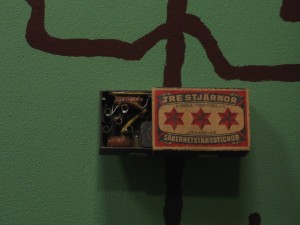
Matchbox radio
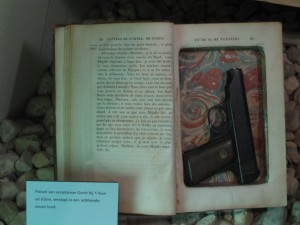
Gun hidden in book
by Cassie, September 3rd, 2009 | 1 Comment
Jonathan and I made it safely to Amsterdam with our bikes in one piece! We’re staying at the awesome Bicycle Hotel with our bikes parked in their bike garage. We’re staying on the fourth floor of the hotel, and the stairs to the fourth floor are crazy! The stairs are so steep that it is almost like climbing a ladder to get to our room! We had lots of fun yesterday exploring Amsterdam and seeing all the canals, neat old buildings, and lots and lots of bikes!
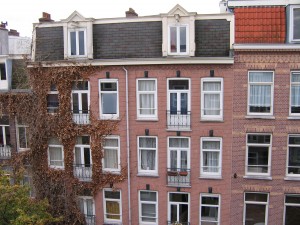
View from our hotel room
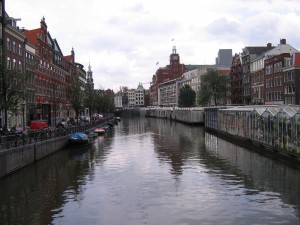
Floating flower market on canal
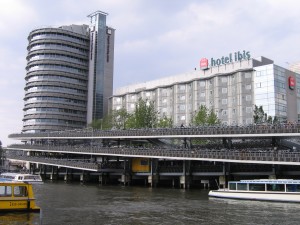
Bicycle garage by Centraal Station
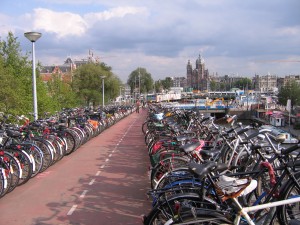
View of St. Nicholas Church from bicycle garage
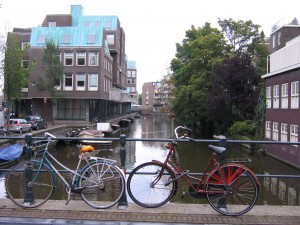
Bikes parked on bridge over canal



































